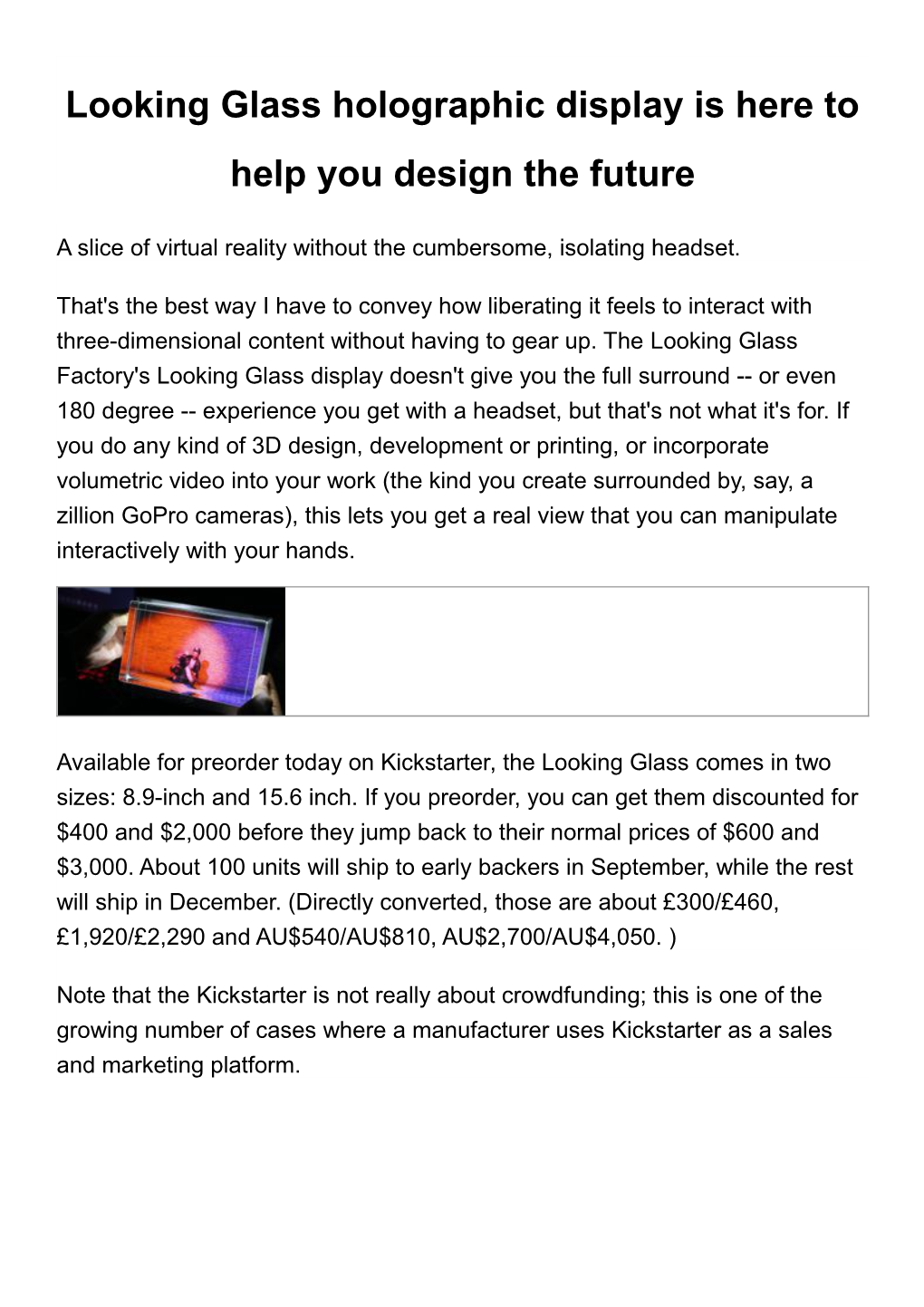Looking Glass holographic display is here to help you design the future
A slice of virtual reality without the cumbersome, isolating headset.
That's the best way I have to convey how liberating it feels to interact with three-dimensional content without having to gear up. The Looking Glass Factory's Looking Glass display doesn't give you the full surround -- or even 180 degree -- experience you get with a headset, but that's not what it's for. If you do any kind of 3D design, development or printing, or incorporate volumetric video into your work (the kind you create surrounded by, say, a zillion GoPro cameras), this lets you get a real view that you can manipulate interactively with your hands.
Available for preorder today on Kickstarter, the Looking Glass comes in two sizes: 8.9-inch and 15.6 inch. If you preorder, you can get them discounted for $400 and $2,000 before they jump back to their normal prices of $600 and $3,000. About 100 units will ship to early backers in September, while the rest will ship in December. (Directly converted, those are about £300/£460, £1,920/£2,290 and AU$540/AU$810, AU$2,700/AU$4,050. )
Note that the Kickstarter is not really about crowdfunding; this is one of the growing number of cases where a manufacturer uses Kickstarter as a sales and marketing platform.
The display comes in two sizes, 8.9 inch/23 cm and 15.6 in/40 cm.
Lori Grunin/CNET
Before you get ready to shell out at least $400 for the Looking Glass, there are some caveats. Most notable, it's not quite ready for consumers, unless your happy fun time consists of creating 3D content or using interactive learning tools, rather than playing games and the like -- the hardware is willing but the software isn't quite there yet. While you'll be able to get some applications and prebuilt models from the App Library in September when it enters limited shipment, the initial launch is really for people who create.
You connect to a computer via USB-C to use a controller (or tracking device) and it recieves the video via HDMI.
Lori Grunin/CNET
For instance, at the moment, Looking Glass primarily supports the Unity engine via its HoloPlay SDK, a Unity plugin that makes any object in the engine viewable and interactive. Why should you care? Well, Unity is a really popular cross-platform game development tool for both desktop (Cuphead, Hollow Knight, and Pillars of Eternity II: Deadfire are just some highlights) and mobile (such as Monument Valley 2, Super Mario Run, Gorogoa and so on).
That means, eventually, games. Hopefully some which take advantage of the display. The company subsequently plans to add integrated viewport support for Maya and Blender and live viewport and export from Rhino, Tinkercad, Solidworks, and ZBrush.
You can interact with the content via a variety of controllers. For instance, the one we tried was connected to a Leap Motion Controller hand tracker. But you can pair it with depth cameras like Intel's Realsense, or game controllers like Nintendo's Joy Con. You connect it to a system, preferably one with discrete graphics, via HDMI for the video signal (at 60fps) and USB-C for controls (and a bit more data).
Through the Looking Glass
While it looks like a big glass block, it's actually comprised of layers of refractive material and there's a lot going on under its hood. The software generates 45 views of a scene or object which the display refracts differently based on your viewing angle (super stereoscopic). Technically, it combines multiview 3D display and volumetric display technologies. That makes it different from other techs we've seen, like Hypervsn and the "nano hologram" still in the research phase, though it incorporates some diffractive lightfield technology similar to that used by the Leia-driven display on the Red Hydrogen One.
Enlarge Image
Looking Glass Factory
Plus, it's not just for viewing. You can interact with objects, which adds a whole new dimension to the experience. (Sorry, not sorry.)
There are a couple drawbacks. The 8.9-inch display really does seem kind of small. And while you don't need to view it head-on, the viewing cone seems to be roughly 90 degrees; once you get about 45 degrees off angle, the effect fades rapidly. But given the relatively small size of the displays, that's fine for a few people to view simultaneously.
Second, they're relatively low resolution. The 8.9-inch display is 4 megapixels and the 15.6-inch is 8MP. That sounds like a lot -- it's the number of pixels in a 4K display, after all. But remember, that's divided into 45 separate views. And if it's on your desk, you're sitting pretty close to it, so you really can see the low pixel pitch, which means you probably won't be able to see details very well (though I didn't try to view any detailed designs). But if you're not sensitive to it, you probably won't be bothered. I'm more sensitive to pixel density than most people.
It looks like a clear glass block, and is as heavy as one.
Lori Grunin/CNET
It's designed to be used in all lighting, but I found it looks a lot better in the dark, because the colors pop more. Plus you don't get distracted by seeing your hands moving in reality and on the screen, so it's a little more immersive.
Despite those drawbacks, though, it still looks pretty impressive.
